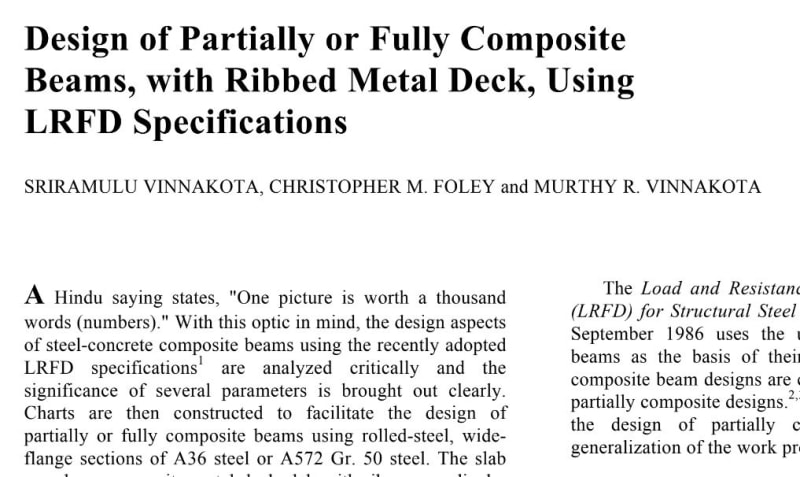CrabbyT
Structural
- Feb 12, 2019
- 165
I'm trying to figure out the composite strength of an existing W24x55 using the AISC 14th SCM.
I started by working my way through the AISC example problems I.1 and I.2 for the 14th edition manual. They calculate the limit states of concrete crushing and tensile yielding of the steel section, and they take the minimum of those 2 things. Then, seemingly randomly, they make this statement: "Fifty percent is used as a trial percentage of composite action as follows" and they multiply the minimum limit state by 50%.
I don't see any mention of this in the code, and I don't get why they're doing this. It seems like voodoo to me, it's like... "Here! Just pick some number between 0 and 1 and that's how composite this system is! Use 0.5, that means it's 50% composite!"
What does it mean if something is 50% composite? I don't know if it even matters for what I'm doing, the W24x55 only has 10 studs between the max moment and the end of the beam, so the max compressive force is something like 10*17.1 = 171 kips, which is well below the limits of concrete crushing and steel yielding in my case.
The commentary in the steel book goes on to state "a fully composite beam corresponds to the case of C governed by the yield strength of the steel beam or the compressive strength of the concrete slab, as in Equation C-I3-6 or C-I3-7. The number and strength of steel headed stud anchors govern C for a partially composite beam as in Equation C-I3-8" (16.1-358).
Based on the design example, they seem to imply that something can be fully composite, but also 50% composite. It sounds like a George Carlin joke.
Can please someone help me make sense of this? Did I miss the trial percentage thing in the code?? Should I throw the trial percentage out the window in my calcs???
I started by working my way through the AISC example problems I.1 and I.2 for the 14th edition manual. They calculate the limit states of concrete crushing and tensile yielding of the steel section, and they take the minimum of those 2 things. Then, seemingly randomly, they make this statement: "Fifty percent is used as a trial percentage of composite action as follows" and they multiply the minimum limit state by 50%.
I don't see any mention of this in the code, and I don't get why they're doing this. It seems like voodoo to me, it's like... "Here! Just pick some number between 0 and 1 and that's how composite this system is! Use 0.5, that means it's 50% composite!"
What does it mean if something is 50% composite? I don't know if it even matters for what I'm doing, the W24x55 only has 10 studs between the max moment and the end of the beam, so the max compressive force is something like 10*17.1 = 171 kips, which is well below the limits of concrete crushing and steel yielding in my case.
The commentary in the steel book goes on to state "a fully composite beam corresponds to the case of C governed by the yield strength of the steel beam or the compressive strength of the concrete slab, as in Equation C-I3-6 or C-I3-7. The number and strength of steel headed stud anchors govern C for a partially composite beam as in Equation C-I3-8" (16.1-358).
Based on the design example, they seem to imply that something can be fully composite, but also 50% composite. It sounds like a George Carlin joke.
Can please someone help me make sense of this? Did I miss the trial percentage thing in the code?? Should I throw the trial percentage out the window in my calcs???

